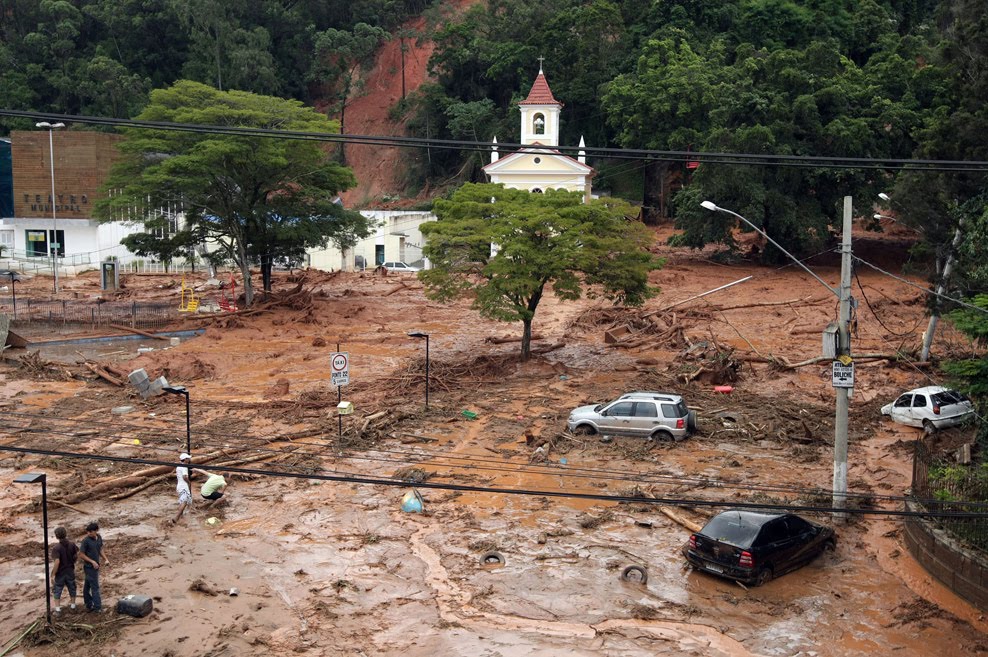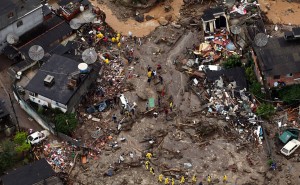South of the Border The view from Latin America
South of The Border - Posted on Friday, January 28, 2011 13:42 - 1 Comment
By Tom Kavanagh
It is a frequent occurrence which blights the beginning of the New Year in Rio state, forcing thousands of people to piece together their lives and belongings in the aftermath of heavy subtropical rainfall. As the water comes down and the earth is unable to absorb it, topsoil turns to mud and begins to run down the hills, submerging and sweeping away everything in its path.
Hastily and precariously constructed residences – perched on hillsides and lacking proper foundations or any form of protection against the deluge – are no match for the torrents of earth that consume all before them. People do not live in these vulnerable dwellings out of choice but out of necessity. Many of the homes destroyed in the latest natural disaster to strike the state never received planning permission in the first place, and there is no inspection of their suitability for human habitation by local authorities. Such issues are overlooked as a matter of course until natural forces thrust them back onto news headlines the world over.
This time last year it was Niterói – situated just over Guanabara Bay from the city of Rio de Janeiro – that paid the heaviest price. In total at least 110 people were killed and more than 4,000 families lost their homes amid some of the heaviest rainfall in recorded history at the start of 2010. That tragedy followed hot on the heels of mudslides on the tourist hotspot of Ilha Grande on New Year’s Eve which killed dozens.
The scene of the latest disaster to hit the state of Rio de Janeiro is just a few hours inland, concentrated around the picturesque towns of Teresópolis and Nova Friburgo around 100 miles from the state capital. These towns have economies largely geared towards catering to domestic tourists: as foreigners flock to the beaches of Ipanema and Copacabana by the thousands, wealthy residents of the city escape to the rolling hills and lush green vegetation which surrounds these cities deep in the state’s interior.
As affluent cariocas (residents of Rio de Janeiro city) began to construct weekend getaways in places like Nova Friburgo, so the servant classes followed them in numbers. Many were the children of those who had come to the South East of Brazil, historically the nation’s wealthiest region and the home of Rio and the industrial powerhouse of São Paulo, from the North East, which in turn has always suffered from entrenched poverty and social marginalisation relative to other parts of the country.
It was Brazil’s North East that received the balance of the millions of African slaves brought to the jewel in the Portuguese crown before and after the nation achieved independence. It is estimated that around 40% of African slaves brought to the Americas were sent to Brazil, and the country was the last in the Western hemisphere to outlaw slave ownership in 1888. The legacy left behind by the institution shows no sign of disappearing into the pages of history.
More than a century on and Afro-Brazilians still sit at the bottom of the pile in terms of virtually every social index, and the North East is still characterised by extreme poverty and disenfranchisement, competing with the Amazon region for the dubious honour of being the poorest region within Latin America’s biggest economy.
Afro-Brazilians have seen countless foreign groups arrive in their wake and quickly leave them trailing in the distance. Communities of Syrians, Italians, Germans, Lebanese and Japanese – the largest anywhere in the world outside of Japan – all thrive in Brazil and for the most part retain a certain sense of cultural identity, while Afro-Brazilians earn the lowest wages, receive the worst education and inhabit the most deprived neighbourhoods.
They are generally crammed into ramshackle communities on the margins of urban civilisation, plagued by the menaces of substance abuse and a plentiful supply of weapons. These neighbourhoods are invaded at alternating junctures by ruthless armed gangs and armed officers of the state, with residents routinely paying extortionate rental prices for the privilege of inhabiting these forgotten districts.
This is how the favelas of Rio de Janeiro came into being – as communities where the droves of impoverished but optimistic North Eastern Brazilians seeking work and opportunity found themselves upon arrival in what must have felt like a foreign land. From here they worked, and indeed still do, as servants for the wealthy, enduring arduous and expensive commutes across town to rich neighbourhoods in order to earn a relative pittance as domestic servants and doormen in expensive apartment blocks, protecting those with money from the people who live in their own communities.
It is these favelas, shamefully visible from virtually any part of Rio de Janeiro, which are the worst hit when the rains come. They stand as a glaring testament to the fact that Brazil is one of the most economically unequal societies on the planet, and for those at the bottom, this is showing few signs of improvement.
When rain poured down in early 2010 and flooding brought the city’s roads to a standstill, dozens perished in Niterói’s slums leaving residents furious at the peceived indifference of the municipal government towards their plight.
As the rains which have so far killed more than 800 and left 400 more unaccounted for began to abate, once again the government was promising to implement an “early warning system”, so as to give people a chance to make it to safety in the likely event of a comparable emergency in the future. Similar promises were made in 2010, but the reality is that the people in these communities have nowhere to go.
Around 15,000 people have been made homeless by the latest bout of rainfall, temporarily focussing the nation’s attention on the problem of housing. It is a question, however, which transcends the issue of how to provide disaster relief: in much of the country the conditions people live in amount to a disaster in and of themselves.
With Rio de Janeiro set to host the final of the World Cup in 2014 and the Olympic Games two years later, the municipal and federal governments have set about trying to clear up the city’s image. Rio is well known to foreigners as much for its poverty and gang violence as for its stunning scenery and iconic statue of Christ the Redeemer. Prior to finding themselves under the glare of the global media spotlight, the authorities are attempting to give the city a full PR makeover.
The process was initiated in 2009 with the first “pacification” programmes targeted at quelling the power of armed gangs in some of the city’s favelas – theoretically ensuring that gangs do not immediately return – as in the past – by taking the unprecedented step of constructing police stations inside the slums themselves.
Critics accuse the government of showing scant regard for those in favelas further outside the city limits, where displaced gangs have relocated, and provoking conflicts with gangs already operating in these communities in the process. There have also been complaints about the heavy-handedness of police operations that have sought to remove gangs from targeted favelas, with significant numbers of residents and others with no connection to gangs finding themselves in the crossfire.
Residents of the city’s poor communities are painfully aware that the government is acting primarily to spare itself heightened embarrassment when the world’s press and media descend on the city in a little over three years’ time, not out of any particular desire to see the lives of ordinary people ameliorated.
The “pacification” policy, critics say, does nothing to address the gargantuan economic disparity at root of the problem, and simply moves armed groups on from one place to another. It is carried out purely to enhance the cosmetic image of the city, which is the only possible explanation for municipal government plans to build a huge wall running along a section of the road to the city’s international airport in order to obscure the enormous conglomerate of slums stretching out below.
The ‘wall of shame’, as the construction has been dubbed, typifies the attitude of government and the wealthy towards the inhabitants of the city’s favelas: out of sight, out of mind. Designed to prevent passers-by from seeing one of the city’s largest, most sprawling slums, Complexo da Maré, from the road above, the wall is already under construction and city are officials are keen to see it completed with time to spare before 2014.
The government is willing to spend the equivalent of millions of pounds, not on providing basic services in the favelas, where investment in health, sanitation and education is desperately needed, but instead on ensuring that tourists being chauffeured from the airport to the affluent South Zone – with its pristine beaches and five-star hotels – don’t have their stay spoiled by a glimpse of the city’s appalling wealth divide.
As Brazil’s poorest are once again in the spotlight for the wrong reasons, with cameras from international news stations beaming pictures of their suffering to all corners of the globe, it is once again clear that the wider context behind their loss will go unreported. Extreme weather events are unavoidable, but the same cannot be said of the scale of destruction witnessed in Rio’s hinterland over recent weeks. It is time that lessons are learnt, time and resource being spent to redress a problem rooted in centuries of inequality.
Tom Kavanagh, a writer and activist based in Argentina, is Latin America correspondent for Ceasefire. His column on Latin American affairs appears every Monday.
1 Comment
Laiz





My parents, who live in Rio, have been to the affected areas every weekend since the disaster. They would have been there every day but cannot afford closing down their small family business as they have no employees. They alerted to the fact that the military is now gone and there is a lack of institutional support as most of the work is now dependant on volunteers (many of which are the victims themselves). Donations arrive in trucks from all over the country, but there is no structure in place to handle the logistics of packing and distributing the donated goods to many of the still isolated villages high up in the hillside. All the work is mainly dependant on charities and local church groups. Last weekend, as they returned to the city of Rio de Janeiro, exhausted and with sore backs from working continuously, they felt frustrated that they couldn’t do more (physically and financially). But mostly, they were outraged that despite the intensive media coverage of the disaster, tens of thousands of healthy ‘carioca’ men and women chose to spend their weekends sitting on the beach drinking beer without a care in the world…